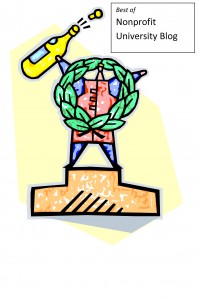The Best Of Nonprofit University Blog
1 comment

What goes up, 3/1/13
Every nonprofit can now be viewed by the exact same population of donors as their peers, collaborators and competitors. And while we know philanthropists have their favorite causes and missions, these sites expose philanthropists to options they otherwise never would have known existed. Now, that philanthropist sitting in the most remote of areas surfing the web can fund 10 miles from her home, 100 miles, around the country, or around the globe. Donors are no longer limited to their own physical reach and experiences. And while this is wonderful for many nonprofits, on the one hand, it may just be the ringing of the death knoll for many others.
Is there a place for the small nonprofit or the one without the compelling stories that stop you in your tracks in the Internet economy?
No way to treat a partner, 2/15/13
From too many nonprofit executive directors’ perspective, funders have nonprofits between a rock and a hard place: they are damned if the stay focused on mission and don’t try to squeeze their round peg into the funders’ square holes and damned if they relinquish mission to chase funders’ current dollars. From the perspective of the nonprofits, failure to play by the funders’ rules means the possibility of extinction. So they choose to stray from mission in order to get funder dollars while trying to cobble together any ways and means to continue those few programs that actually serve mission. Those few programs that actually serve the real needs of that portion of the public on whose behalf the organization was intended and supposed to work.
Does this sound like the path to creating healthy, vibrant, sustainable communities for all? In our society, there is, sadly, such widespread acceptance of the false equation money=smart, that we presume that anyone with money knows best. Money simply means money. Years in the field, years working in the problem and on the problem, means knowledge, understanding, awareness. The current paradigm of allowing the money to dictate the solutions while those who have their hands in the dirt are closed out of the determination process puts us all at risk.
Having it all, 11/2/12
Why is it that nonprofits don’t stay focused on what they are supposed to be? Why is it that too many organizations try to be more than they can be? In criminology, there is the Law of Saturation which says, if I may bastardize the explanation and make it very basic, that, in essence, each society has as much crime as it and its systems can tolerate and handle. Would that nonprofits spent time assessing their true saturation point, and did not try to be more than they had the capacity to be, to do more when they really should be working to doing better, to be content to be the best at what they should be doing, even if what they should be doing is focused and narrow. If only nonprofits truly valued quality rather than quantity, we’d have a stronger nonprofit sector doing a better job of responding to the needs of our people and our communities. Instead, too many nonprofits prefer purgatory – but not of perfection – and failure.
How do we value nonprofits? 10/19/12
While I have gone on record supporting the notion that nonprofits should be responsible for the share of city services which they use, I have also gone on record saying that nonprofits are not the solution to others’ failed business planning. Governments must find other solutions to their own financial crisis.
The brand of the “nonprofit sector” should be consistently, and highly, valued for what they are and not be used as a funding stream for for-profits and governments.
Why we give, 8/24/12
Tehila Kogut, from Ben Gurion University, through a series of research projects, found that some people give to charity to ward off the very disaster the charity addresses. You give to the homeless organization so you don’t become homeless, to the cancer organization so you and your loved ones don’t get cancer, to the literacy organization so that all your children learn to read. So, do we give to celebrities who represent the things which we want to prevent?
Willful Blindness, 5/4/12
How many executive directors really know how the employees in their organizations are executing their duties? Sadly, children dying in foster care is becoming too common place ”to think that there is not something wrong with a system that allows that to happen. There isn’t a person, from the bottom of an organizational chart to the top of that chart who works in a nonprofit where employees—call them case managers, advisors, SCOH workers, whatever—have a responsibility to oversee a specified number of clients who doesn’t know that the number of clients per employee is well beyond what one individual can handle responsibly. Which means every executive director of such an organization is complicit in allowing a system to continue that can’t possibly guarantee the promises the organization makes. Willful blindness. The board, too, which should be receiving regular reports and outcome studies, knows, as well. The willfully blind leading the willfully blind
The opinions expressed in Nonprofit University Blog are those of writer and do not necessarily reflect the opinion of La Salle University or any other institution or individual.

One thought on “The Best Of Nonprofit University Blog”